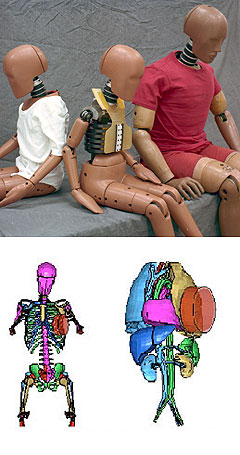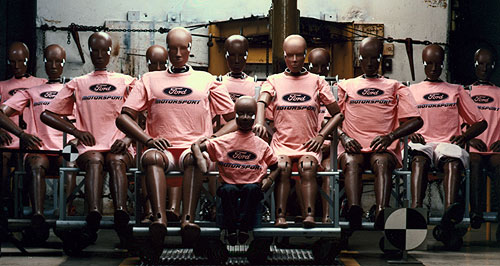News - FordVirtual child to help crash safetyStrike a pose: Ford's 'family' of crash test dummies. Ford is developing a digital child crash test dummy with lifelike internals4 Apr 2011 THE quest to further improve the quality of crash testing has led the Ford Motor Company to begin development of a ‘virtual’ child to use as a crash test dummy in simulated accidents. Ford claims it is one of the first research projects to build a digital human model of a child with more lifelike recreations of the skeletal structure, internal organs and brain. It follows a similar program by the Detroit car-maker to build a digital adult in painstaking detail, which took some 11 years to complete and concluded in 2004. Ford said it is building the child model to better understand how crash forces affect children and adults differently. Senior technical leader for safety at Ford Research and Advanced Engineering, Steve Rouhana, said the project began after injury trends showed that children are generally more vulnerable in crashes.  “We study injury trends in the field, and we know that traffic crashes are the leading cause of death for people from age one to 34,” said Dr Rouhana. “We want to better understand how injuries to younger occupants may be different. The more you know about the human body, the more we can consider how to make our restraint systems even better. “A child’s body is very different from an adult’s. Building a digital human model of a child will help us design future systems that offer better protection for our young passengers.” Extensive research is required on each individual component in the digital model, especially the brain, skull, neck and ribcage. The brain in Ford’s adult human digital model was constructed as a separate component, detailed down to the stem, the grey matter and the fluid between the layers. “Building the model of a person is just like building a model of a car,” said Dr Rouhana. “You start with your surface geometry for each component and any subcomponent it contains – in this case the geometry of the human body and its internal organs.” With little data available on children, Ford contracted Tianjin University of Science and Technology near Beijing in China, which works closely with a local children’s hospital, to obtain child geometry and basic body information from sources like MRIs and CAT scans. This data is used in conjunction with anatomical information to develop components that will then be joined into a whole virtual human body, which will be extensively validated. Virtual dummies are not designed to replace actual crash test dummies, which measure the effect of forces on the body and are vital in vehicle development. Instead, they will be employed to improve restraint system effectiveness in the early CAD stages of vehicle design, just as computer systems are used to develop deformable structures and crashworthiness ahead of expensive and time-consuming actual crash tests.  Read more |
Click to shareFord articlesResearch Ford Motor industry news |
















Facebook Twitter Instagram